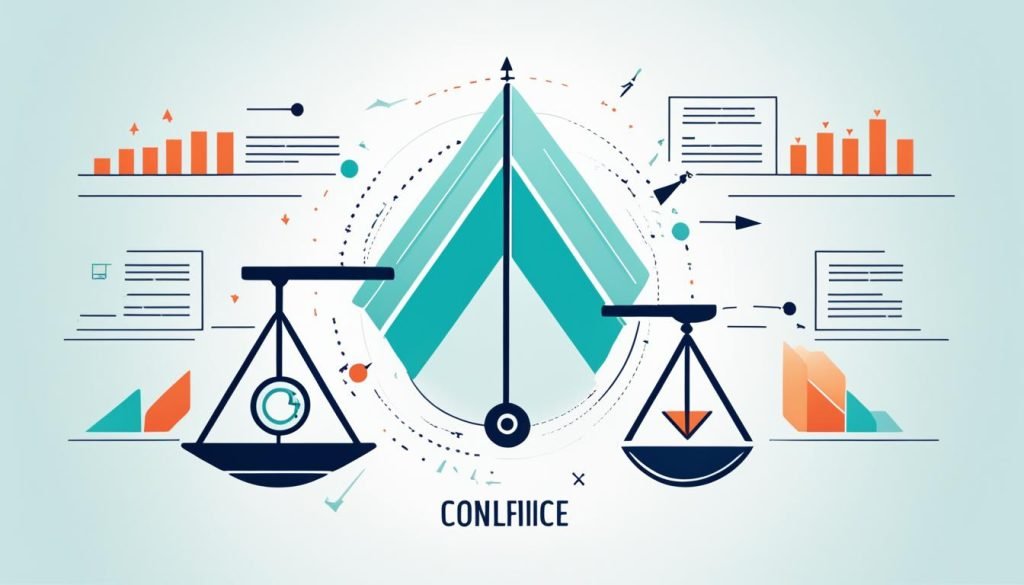In today’s fast-changing business world, making policy changes is key. Companies face big challenges from globalization, new tech, and changing what customers want. It’s vital to adjust to these changes to stay ahead and succeed over time.
By adapting, companies get better at what they do and become more innovative and strong. With more ups and downs ahead, it’s important for businesses to learn fast and be flexible. This helps them make good plans that fit the market and what people expect.
Key Takeaways
- Business policy changes are critical for long-term adaptability.
- Globalization poses both challenges and opportunities for organizations.
- Technological advancements drive the need for immediate policy shifts.
- Consumer preferences are constantly evolving, requiring agile strategies.
- A culture of innovation is crucial for organizational effectiveness.
- Rapid learning enhances competitiveness in a volatile market.
The Importance of Business Policy Changes
Today’s business world is complex and always changing. Making changes to business policies is crucial for staying ahead. It’s key to adjust to new trends and what customers want.
Understanding the Need for Adaptation
Being proactive helps companies deal with uncertainty. Markets change often, so businesses must check their plans regularly. By spotting trends early and changing policies, companies can work better and meet customer needs.
The Impact of Globalization on Policies
Globalization changes how businesses work worldwide. Companies now need policies that respect different cultures and ensure clear communication. It’s important to understand these changes to build a strong, global business.
| Aspect | Before Globalization | After Globalization |
|---|---|---|
| Market Approach | Local Strategies | Global Strategies |
| Policy Flexibility | Static Policies | Dynamic Policies |
| Customer Interaction | One-way Communication | Two-way Communication |
| Competitive Advantage | Traditional Competitors | Global Competitors |
Key Drivers of Organizational Restructuring
In today’s fast-changing business world, making changes in how a company is structured is a must. New tech and changing what customers want drive this need. Companies need to keep up with these changes to stay ahead.
Technological Advancements and their Role
Technology has a big impact, making businesses more efficient and quick to respond. Those who adopt new tech can better meet market needs. Automation, AI, and data analytics help streamline processes, making things more productive and cheaper.
Using these technologies also leads to new products that customers want. This keeps businesses competitive.
Changing Consumer Preferences and Expectations
What customers want is always changing, pushing companies to rethink their strategies. Staying in touch with these changes is key to offering the right products and services. Doing market research and being quick to adapt is crucial.
Meeting customer needs through personalized and eco-friendly options can make customers more loyal. Not keeping up with these changes can lead to losing customers to competitors who are more agile.

| Key Driver | Description | Impact on Organizational Restructuring |
|---|---|---|
| Technological Advancements | Integration of automation, AI, and data analytics. | Enhances efficiency and accelerates adaptation. |
| Consumer Behavior Changes | Shifting preferences towards personalization and sustainability. | Encourages tailored products and services. |
Compliance Regulations and Corporate Governance
In today’s fast-changing business world, companies must follow strict rules and have good corporate governance. As industries grow and new tech comes out, staying in line with these rules is key. It helps protect a company’s good name and ensures it can keep going.
Navigating New Compliance Standards
It’s vital for businesses to keep up with changing rules to lower risks and work better. They need to know about new laws, especially those about tech, finance, and keeping data private. It’s smart for companies to spend on training and tools to help workers understand and follow these rules. This helps build a strong plan for managing risks.
Implementing Strong Corporate Governance Practices
Good corporate governance makes companies more accountable and transparent. It helps lower risks and builds trust with people who matter to the company. Important things to think about include:
- Establishment of a clear governance structure: Make sure everyone knows their job.
- Regular training programs: Make sure workers know the rules and how to handle risks.
- Monitoring and assessment of compliance: Always check how well you’re following the rules to see where you can get better.
By focusing on good governance and knowing the rules, companies can get ready for what’s coming and stay true to their values.

| Governance Best Practices | Compliance Benefits |
|---|---|
| Defined roles and accountability | Reduced legal risks |
| Regular stakeholder engagement | Enhanced transparency |
| Effective internal controls | Improved operational efficiency |
Business Policy Changes for Strategy Shifts
In today’s fast-changing world, businesses must update their policies to stay on track. They need to focus on new strategies that match the market. By keeping an eye on market trends, companies can act fast and meet consumer needs and competition.
Aligning with Market Trends
Successful companies know how vital it is to match market trends. This lets them grab new chances as they come up. By watching industry changes and what customers want, they can change quickly. This way, their policies connect well with their audience.
Utilizing Data for Decision-Making
Using data to make decisions is key for companies wanting to change their strategies. Good data helps leaders spot trends, predict the future, and make smart choices. This helps businesses grow and stay relevant over time.
| Business Factors | Traditional Approach | Data-Driven Approach |
|---|---|---|
| Market Analysis | Annual Reports | Real-Time Analytics |
| Decision-Making | Intuition-Based | Data Focused |
| Response Time | Slow Adaptation | Agile and Swift |
| Growth Opportunities | Reactive Exploration | Proactive Identification |
Operational Overhauls: Enhancing Efficiency
Many organizations want to make their operations more efficient. They do this by changing their processes in a planned way. This helps them work better and be more productive. Process reengineering and lean methodologies are two key ways to achieve this.
Process Reengineering Approaches
Process reengineering looks closely at how things are done now to find what’s not working well. It brings new ideas to old problems, leading to better solutions. By changing how work is done, companies can work faster and better.
The goal is to add more value and use fewer resources. This makes operations more efficient.
Adopting Lean and Agile Methodologies
Lean methodologies help remove things that don’t add value. They focus on making high-quality products or services. This approach encourages always getting better and being able to change quickly.
Agile methods work well with this, by listening to customers and adapting to new trends. Together, these strategies help companies stay efficient and meet new challenges.
Workforce Adjustments and Cultural Transformations
Organizations face many changes and need to adjust their workforce and culture. They must build a strong culture where workers feel empowered and ready for new challenges. This helps them adapt to changes in their work.
Fostering a Culture of Resilience
Having a resilient culture is key when the market keeps changing. It means making a place where workers can adjust to new situations without worrying. Leaders should promote open talks, support systems, and a growth mindset.
This approach boosts employee involvement and helps solve problems together. It leads to better results during big changes.
Engaging Employees in Change Processes
Getting employees involved in changes makes them feel important and heard. Keeping them informed about changes helps reduce worry and builds trust. Training and workshops are important to prepare staff for new tasks.
Recognizing their hard work and contributions during these times boosts their commitment. It keeps everyone’s spirits high.
Conclusion
In today’s fast-changing business world, it’s crucial for companies to adapt their policies. They need to keep up with globalization, new tech, and changing rules. This helps them stay strong and successful over time.
When companies change how they work and update their culture, they get ready for the future. This proactive way helps them work better and be more innovative. It turns challenges into chances for growth, making adaptation key to success.
By tackling the challenges discussed here, businesses can meet today’s needs and get ready for tomorrow’s. The way to a strong and adaptable company is through smart policy changes. These changes help in adapting in all parts of the business.






